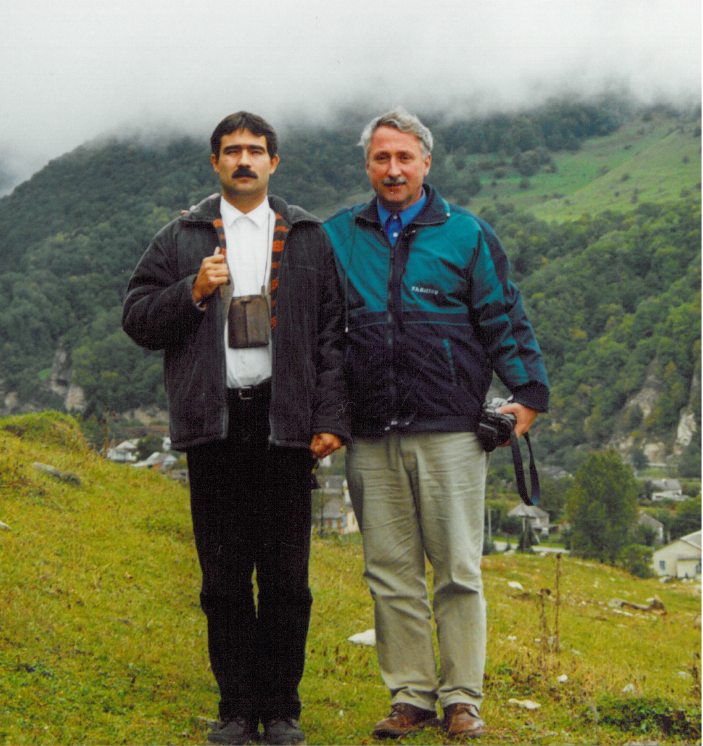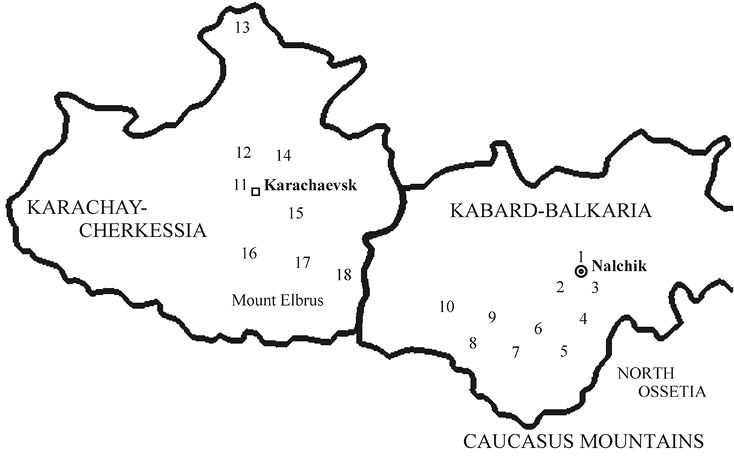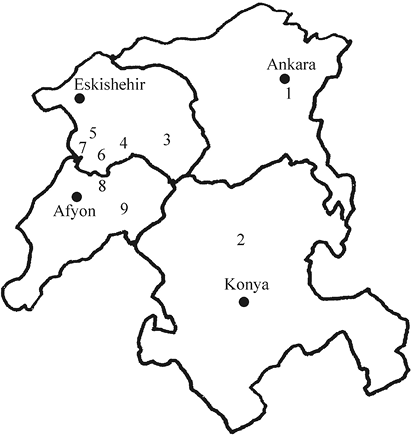- Karachay folk music
- Special tunes
- The classes of Karachay folk music
- Class 1: Rotating and plagal motion (№ 1−8)
- Class 2: One or two short lines and their variations with x(1)1 cadences (№ 9-37)
- Class 3: Four short lines with (1) main cadence (№ 38-53)
- Class 4: Four short lines with the first line ending on the key note, with a (pseudo) domed structure and 1(x)y cadences (№ 54−62)
- Class 5: Four short lines with (VII) main cadence (№ 63−70)
- Class 6: Four short lines with (2) and (b3) main cadences (№ 71−105)
- Class 7: Four short lines with (4/5) main cadences (№ 106−115)
- Class 8: Four short lines with (4/5) main cadence and a higher beginning (№ 116−138)
- Class 9: Four short lines with (7/8) main cadences (№ 139−145)
- Class 10: One- or two-lined tripodic tunes (№ 146–186)
- Class 11: Tunes with four tripodic lines (№ 187–199)
- Class 12: Jir tunes (№ 200–278)
- Class 13: Four long lines with arched (domed) structure (№ 279–287)
- Connections between Hungarian and Karachay folk music
About our Karachay collecting field-trips
The examination of Karachay-Balkar folk music began – as is customary in Hungarian folk music research – with on-the-spot collection. Thus, the great part of our analyzed material is from two field trips in the Caucasus and three among Karachays in Turkey. In addition, I have studied Dr. Tamara Bittirova’s Caucasian collection from before 2000, some commercial cassettes and Omar Otarov’s book (2001) on Karachay folksongs, and have inserted a few tunes from them into this volume.
The approximately 1200 tunes thus collected were then transcribed and analyzed, then I picked 71 for illustrative examples and 287 for the collection of tunes. These 358 tunes represent adequately the collection, which in turn represents aptly the folk music of the Karachay-Balkas in both the Caucasus and in Turkey. Obviously, important strata of this folk music have changed over the centuries, some disappearing, new ones emerging, and therefore, here “only” the present state of Karachay-Balkar folk music is presented. However, in view of the archaic features of a great part of our material, e.g. the high number of tunes performed parlando-rubato or the many different traditional genres, one may hope that the material will allow an insight into the more distant past of Karachay folk music.
In the chapters on the Karachay-Balkar people and Karachay folk music we are trying to give a scientifically accurate account of the emergence, customs, musical layers of the Karachays, of their cultural connections with other ethnic groups, etc. In the next few paragraphs I will outline in brief our research trips, the collected material and my general impressions.
Field research of János Sipos and Gergely Agócs
in the Caucasus in 2000
The Karachay-Balkar people live in the northern areas close to the Caucasus in the Karachay-Cherkess and Kabard-Balkar Republics belonging to the Russian Federation. The Karachays and Balkars are one ethnicity with a common Turkic tongue, common history and culture. Their language belongs to the Caucasian branch of the Kipchak group of Turkic languages. We first visited them in both the Kabard-Balkar and the Karachay-Cherkess republics in September-October 2000. The opportunity was a conference on the Nart epic in the Kabard-Balkar capital, Nalchik, and a related field research upon the invitation of Svetlana Dashieva, a vice rector of the Kabard-Balkar State University.
The atmosphere being fairly explosive in that corner of the world at that time, we had to append the following letter to our application for visa to the Consular Division of the Hungarian Republic:
“Dear Madam,
The undersigned Dr. János Sipos and Gergely Agócs would like to travel to the Karachay-Cherkess and Kabard-Balkar area between 25 September and 5 October 2000. We are research fellows of the Institute for Musicology of HAS and the Oriental Archive of House of Hungarian Heritage but at present we will travel independently, without being delegated.
Our plane is to leave at 9 o’clock on Monday, 25 September, and we have not received our invitation letters yet. We kindly ask you to help us receive the Russian visa this week, with urgency. Our general project and current trip has been supported by the political secretary Mr. Zsolt Németh.
I, János Sipos, acknowledge that the Foreign Ministry does not advise travelling to the Karachay-Cherkess and Kabard Balkar areas and declare that despite this warning, I undertake the risk of travelling there at my own peril in the interest of folk music research.
Sincerely yours,
Dr. János Sipos
Budapest, September 20, 2000
We knew that the radioactive matter sunk in Lake Karachay was dangerously polluting the environment and the efforts to clean up were stopped in 1998 for lack of resources. We had to consider that the Chechen-Russian war was going on some one hundred km away from Nalchik and the Chechens were taking hostages in the surrounding areas, too. But when a researcher is determined, he will not give up and our plane took off on 25 September 2000, headed for Moscow from where – at a delay of 8 hours – we flew to Nalchik the same night.
The field research was highly successful, we returned with a stock of 280 tunes most of them recorded from reliable informants in the Balkar villages of Kasha Tau, Kara suv, Bizingi, Yanikoy and Ogari Malkar locations, and in the Karachay villages of Ogari Mara, Karachaevsk, and Teberdi. We also
made important recordings at the Ethnographic Research Institute and the Radio in Nalchik, as well as at two folk music concerts. We recorded not only the songs and beliefs of Turkic people, but also some of the Cherkes and Kabard groups speaking Ibero-Caucasian tongues, and we also collected from Cherkes people who had come to the Nart conference from Turkey and Syria. We also received materials from the folk music collection of Balkar researcher Tamara Bittirova and acquired all accessible publications, most devoted to the folklore of the majority Kabards.

Picture 1. Gergely Agócs and János Sipos in the Caucasus Mountains
Fieldwork of János Sipos and Éva Csáki among the Karachays in Turkey
Since I go to Turkey like my second home, I decided that in addition to uncertain and dangerous research in the Caucasus, I would carry on fieldwork among the Karachays who fled from the Russian expansion to Turkey. I made the first trip with my wife Turkic scholar Éva Csáki, who has been my companion for several earlier and recent research expeditions.
In 2001 we visited the following villages and towns populated by Karachays (too): Bashhüyük, Eskishehir, Yakapinar (Ertugrul), Afyon, Bolvadin, Doglat, Yazilikaya and Konya. We made many interviews about their history, customs, and recorded some 160 tunes. We also visited Crimean Tatar and Volga Tatar villages nearby whose inhabitants had also escaped from the Russians in the early 20th century. Added to that, we received 50 Karachay-Balkar tunes from Mr. Vedat Malkan and 50 from Mr. Ufuk Tavkul. This expedition resulted in a total of 260 tunes for our collection.
In those years Turkey was hit by an economic crisis. Karachay women hardly married before thirty and only had one or two children. Life expectancy decreased as did the number of children. The Karachays of Turkey have not been wholly assimilated; they preserve their tongue and some archaic elements of their culture. That was in spite of the fact that similarly to other minorities, their language was not taught in Turkish schools. Karachays in towns are closer to assimilation, they frequently marry from other ethnicities, but they also speak their original tongue, i.e. they are bilingual, fluently changing from Karachay to Turkish and back. In the towns there are Karachay derneks (Societies) where they can come together to socialize, or celebrate religious and other feasts. In villages, obviously, tradition lives on more powerfully.
The songs of the old religion and usually songs performed parlando-rubato are mainly known by middle-aged and older people, despite the recent revival among the young people who are also proud of being Karachay and are ready to sing dance tunes of Karachay music, unfortunately not the most valuable tunes. They supply the music for weddings singing, playing the accordion and the rhythmic beating of wooden boards in their hands.
Turkish society has welcomed the Karachays, respecting them as hard-working, well-educated people, not without justification, too. Those who have money are intent on learning and sending their children to school, which is an important life principle for them.
Éva Csáki’s Karachay collecting trips in Turkey in 2001 and 2002
In October 2001 and April 2002 Éva Csáki visited Karachays around Ankara, accompanied on both occasions by Ufuk Tavkul. She collected some twenty tunes, first of all in the village of Yaglipinar.
Yaglipinar is 35 km away from Ankara; its old name is Akhısar < Ağaşar ‘white town’. The settlers arrived here from around Chegem, Mara and Bashan in the Caucasus in the 1890s. In 1921, the village comprised 55 houses, of which 13 had inhabitants from Chegem.
At that time, there was still a huge pine tree in the cemetery, but the local authorities had it felled for they didn’t like the Karachays’ veneration of it as a sacred tree. That did not deter the Karachays from worshipping the solitary tree and regarded even its shavings as holy. The grave of a saint, Ashamish, used to be under the holy tree. Legend has it that he was once the servant of an upper Balkarian lord called Küchüker. The master sent him to get a horse, but he got stuck on the way home and the horse went astray. The squire set out to seek them and when he chanced upon Ashamish sleeping, he cut his head off. The villagers buried him. One night a green light emerged from the grave, so it became a sacred place. During a drought or flood they gather around his grave to make an offering. Finally, they tie small pieces of rag chaput on the holy tree with secret wishes.
János Sipos’ fieldwork in Turkey in August-September 2005
In 2005, at first I also worked among the Karachays in and around Ankara (Gölbashi, Yaglipinar). The dwellers of these villages also speak the Karachay tongue but being close to the capital, they only preserve traces of the more archaic culture. Most people commute to Ankara to work, assimilation has been advanced. The more ancient tunes are known by girls or women who came here to marry from more traditional areas such as Afyon or Eskishehir.
Then I visited Eskishehir and the surrounding villages (Chifteler, Belpinar-Chogetey, Yazilikaya, Akhisar, Kilissa, Bolvadin, Doglat and Yakapinar). I also sojourned in some Crimean Tatar, Volga Tatar and Kumyk communities. I had the special luck of being recommended to the vali of Eskishehir by Hürriyet Ersoy, chairwoman of the Karachay Society of Ankara. The governor summoned the head of the Il Kültür Müdürü (regional cultural department) and the president of the local Karachay society Basri Özen, gave us a car and off we went on a collecting spree.
I had the chance to study the culture of the fairly populous Eskishehir community in detail. In the intervals of fieldwork in the villages I visited the Karachay Society in Eskishehir, took part in weddings and complemented my religious song (zikir) collection. I had a good opportunity to observe the changes in the music life of the Karachays.
In Turkey the question as to who is a Turk is sometimes raised. Some claim that “the whole world is Turkish”, but most of them have a more subtle approach to the question. Many people see the complex ethnogenesis of Anatolia clearly, some even speak of a mosaic nation, which is not really true in this extreme form. Anyhow, as descendants of a great ruling people, culture and empire, they do not need deep nationalistic feelings. The complexity of the situation is well exemplified by our small research team: the driver’s family were Turks from Bulgaria, the ancestors of the delegate of the Cultural Ministry came from old Yugoslavia, and our guide was Karachay from the Caucasus Montains.
I revisited some villages I had been to earlier, and practically worked in every Karachay village in the area. The fieldwork ended with the fine result of 250 recorded tunes. By the end of the expedition, I had recorded the majority of the Karachay tune types in Turkey. At the beginning of this field research I came across a new tune now and then, but in the last week all I could find were close variants of the already recorded types.
The only thing I needed was a control material, but to my greatest joy it also came about.
The field research of Gergely Agócs and József Lukács
among the Caucasian Karachay-Balkars in 2007
In August 2007 Gergely Agócs and József Lukács went on a two-week research trip to the Karachay-Balkars in the Caucasus. In addition to communities we had visited together seven years earlier, they also gathered data in so-far unresearched valleys and succeeded in making recordings of great ethnomusicological value for Hungarian folk music research in Noghay settlements.
Their logbook says they recorded 357 tunes from 63 informants at 29 venues in 15 villages. They had the folk music archive of Nalchik Radio copied, of which about 60% can be taken for authentic recording, but in the rest of the tunes stage ensembles also usually accompany “informants” of some traditional performance.
With a collection of 1200 transcribed and analyzed tunes at my disposal, I settled down to the synthesizing and comparative study of Karachay folk music.
Map of the places where the tunes in this volume were recorded
To understand the below map of the Caucasus, it is important to know that the Adyghe, Cherkes and Kabard groups are related, and the Karachay and Balkar people are practically identical. The Russians, however, utilizing the principle of “divide and rule” forced these ethnic groups into the Karachay-Cherkes and Kabard-Balkar Republics, while the western Cherkes people, the Adyghes are now in the Adyghe Republic.

Map 1. Collecting sites of the Caucasian tunes included in the volume
Kabard-Balkaria: 1. Nalchik (Nalçik)1, 2. Yanikoy, 3. Hasaniya, 4. Kashha Tau (Kaşha Tav), 5. Ogari Malkar (Ogarı Malkar), 6. Kara Suv, 7. Bizingi (Bızıngı), 8. Ogari Chegem (Ogarı Çegem), 9. Töben Chegem (Töben Çegem), 10. Billim (Bıllım)
Karachay-Cherkessia: 11. Karachaevsk, 12. Dzhögetey Ayagi (Cögetey Ayagı), 13. Cherkessk (Çerkessk), 14. Dzhögetey Dzhangi (Cögetey Cangı), 15. Ogari Mara (Ogarı Mara), 16. Teberdi, 17. Uchkulan (Uçkulan), 18. Hurzuk

Collecting sites in Turkey: Eskishehir (Eskişehir), Ankara, Afyon and 1. Yahlipinar (Yağlıpınar), 2. Bashhüyük (Başhüyük), 3. Yakapinar- Ertugrul (Yakapınar-Ertuğrul), 4. Belpinar (Belpınar), 5. Yazilikaya (Yazılıkaya), 6. Kilisa (Orhaniye), 7. Akhisar, 8. Doglat (Doğlat), 9. Bolvadin
1 From different people, the Iyman ensemble of the radio, at a folk music concert and in the archive of Nalchik Radio.
